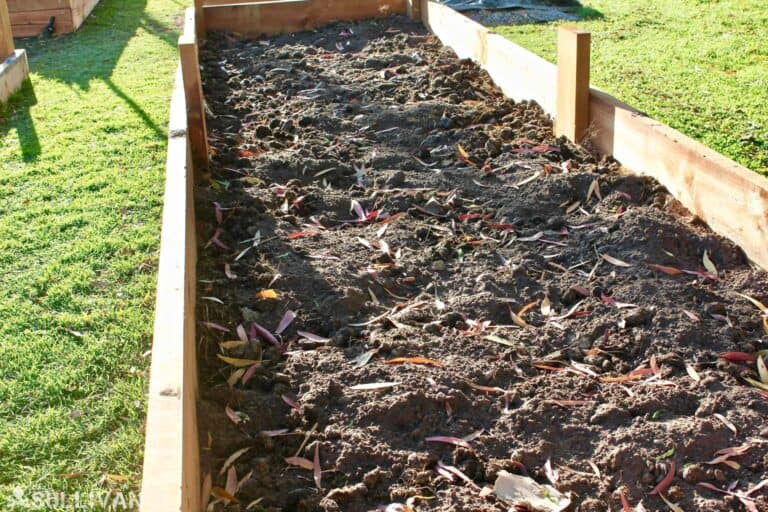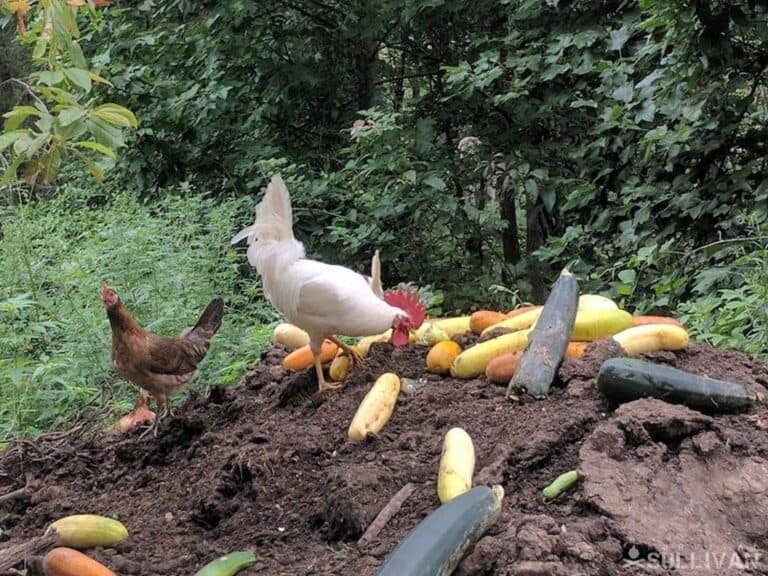The fertility of your land doesn’t remain constant, especially if you deplete the soil by growing vegetables and fruit. Just like anything else, your land must be nourished and properly cared for to continue growing food to supply your family.
Keeping your land fertile first requires that you used that makes a good soil. Organic gardening and farming require at least a basic understanding of the complex nature of the soil.
There is so much hidden inside of simple dirt. Of course, you can also pump non-organic fillers and vitamins into your soil to give it boosts. However, that is not a sustainable method.
When we are thinking about surviving for years to come, we have to remember that stores may not be available for us to purchase fertilizers. Luckily, organic methods have worked for centuries to keep the land fertile.
The soil is truly a complex system of food that lives inside of your garden beds. Soil is alive. There are earthworms, bacteria, fungi, mites, and microscopic organisms. These organisms release vital mineral nutrients into the soil.
There are many ways to keep your land fertile throughout the years. Most of these methods can and should be used together for maximum results.
Use Your Compost
Every gardener and survivalist should have a working compost. The process is easy. You need an area where you can keep brown and green materials as they break down into compost.

Most things can be placed into your compost, except dairy products, cat and dog feces, and meat products. If you garden and have a yard, you will have items to compost. Some ideas are:
- Eggshells
- Vegetable and fruit scraps
- Twigs and branches
- Dead Weeds
- Herb clippings
- Grass clippings
- Shredded newspaper
- Dried leaves
- Coffee grounds and tea leaves
Chances are you have a plethora of things to compost. Why does composting benefit the fertility of your land? As these items break down into compost, you create a nutrient-dense soil that will benefit your plants.

Compost helps to increase the soil structure by adding inorganic particles with decayed, organic particles. Proper soil structure allows air to circulate and water to move freely.
Use Mulch
If you have a vegetable garden, using organic mulch is vital for its health. I don’t mean that you need to go out and buy bags of wood chips from the store. Remember that is not a sustainable practice. There are plenty of choices.
Organic mulches offer your soil benefits that other choices do not. While they all stop the growth and germinate of weeds, mulch will help to retain the moisture of your soil for longer, which helps during dry spells. Water is essential for fertility and proper growth. Mulch also helps to regulate soil temperature. During hot days, the soil stays cooler; during cooler days, the soil is warmer.
Another benefit is that organic mulch is it will add nutrients to your soil. This benefit is different than if you pick wood chips. Organic mulch will break down over time, allowing nutrients to seep into the soil. You can pick different mulches for each garden bed, depending on the plants there and nutrients required.
What types of organic mulches can you use? A few of my favorite choices are:
- Grass clippings: A typically free source of nitrogen that decomposes easily.
- Straw: Offers similar benefits as grass clippings, but it decomposes at a much slower rate.
- Shredded Leaves: Another free source available to most gardeners that helps to loosen soil and add nutrients.
- Newspapers: If the company uses organic dyes, the newspaper can help to block out weeds while eventually breaking down completely.
Crop Rotation
One of the oldest practices is crop rotation. Ancient Egyptians began this practice thousands of years ago when they would switch fields each year and plant different crops. It is a practice that we can and should still use today.
Typically, crop rotation is when you have a deep-rooted rap planted in one garden bed or area that year. Then, the next year you would plant a shallow rooted crop instead. Modern farming typically involves a three-field crop rotation.
The reason why crop rotation increases land fertility is that growing the same crop in the same soil every year depletes the soil nutrients. Every plant has their unique nutrient requirement. Plants also leave different nutrients in the soil. Rotating the plants each year helps to replace vital nutrients back into the soil. There are other benefits as well!
- Slows down the spread of pests and diseases
- Reduces the need for artificial fertilizers
- Allows you to grow more food and harvest at different times.
- Improves the nutrients in soil through green manure
- Reduces weeds
- Improves the soil structure
- Reduces soil erosion
Planting a Cover Crop
Never heard of a cover crop? That’s okay; I didn’t for years! It is one of the least used methods by home gardeners, but the benefits shouldn’t be discounted. Let’s take a look at what cover crops and why you should use them.
A cover crop is any plant that you grow specifically to improve your soil. The practice started in the early 1900s to restore the fertility of the land. You have a variety of choices available. Here are some of the favorites!
- Legumes: You can grow legumes as food or as a cover crop. The soil gets the most benefits if you don’t harvest the crop. Legumes planted in the fall help to decrease winter soil erosion.
- Alfalfa: Alfalfa is a perennial plant that is best if sown in the spring or summer. It has aggressive secondary roots.
- Clovers: There are several choices in the clover cover crop category such as Berseem Clover, Crimson Clover, Red Clover and Dutch White Clover. You will find annuals and perennials! Some are a winter-hardy choice that grows to three feet tall. Other choices are biennials that grow from spring through fall. You have to find the choice that fits your needs.
- Peas: Here is another edible legume that tends to be cold-hardy. You want a field pea that will grow rapidly in the spring. You plant them in the fall or very early spring.
Cover crops, when used properly, offer a wealth of benefits of gardeners. It will increase the organic matter in your soil, prevent soil erosion, stop the growth of weeds and cycle soil-borne nutrients. There are two other benefits that you should know as well.
- Rhizodeposition is a special benefit of cover crops. It means that the plant release sugars and other vital substances into the roots of your soil. Some cover crops can go as far as six feet into the ground! Most gardeners never dig that deep! The roots of the cover crops host sugars that encourage the growth of helpful microorganisms.
- Bio-Drilling is a term that means the cover crops can dig, or “drill,” deep into the compacted Some plants can dig into the tight soil, creating a map or system for the next plant you pick to grow there!
No-Till Farming
Something newer on the scene is learning how to farm and garden without the use of tilling. No-till does preserve the topsoil and reduces soil erosion.
Many gardeners till the earth up to a foot deep with a plow or a motorized tiller. Typically, you plant your seedlings in the leftovers of the previous plants, weeds and other things in the soil.
Tilling is done because gardeners believe that it loosens up the soil, allowing oxygen and water to flow easily to the roots. However, by turning the soil, farmers are moving the organic-matter to the stop of the soil and also creates soil that will become denser with rain and watering.
One of the negatives of tilling is that it creates soil erosion. Tilling disrupts and breaks up the structure of the soil, allowing soil and particles to blow away or get washed away during heavy rains.
At the same time, the essential organic matter in your soil is damaged, including beetles earthworms, bacteria, and fungi. You need those for healthy plants!
On the other hand, no-till agriculture allows gardeners to plant their crops and control pesky weeds without the need for turning the soil. Instead of using disks or a plow, gardeners can use a narrow furrow that allows seeds to be injected into the soil. At the same time, fertilizers are added. The pros of no-tilling include:
- Conserving water
- Reducing erosion
- Less labor to grow crops
- Fewer fossil fuels used
Of course, one of the negatives includes more weeds. However, there are organic ways to get rid of weeds. If you want to continue to create fertile land, put away that tiller!
Make Soil Amendments
There are times when your soil needs amendments. Amendments are anything that you add to the soil to help its properties and how it holds water. There are several types of soils such as clay, sandy and silt.
If you have clay soil, some amendment choices are:
- Peat Moss: aerates the soil
- Lime: Increase the pH and loosens soil
- Sand: Improves drainage
If you have sandy soil, some amendment choices are:
- Clay Soil: Improves water retention
- Compost: Acts as a conditioner
- Peat Moss: Helps retain water
If you have silt soil, amendment choices are:
- Course Sand: Improves drainage
- Manure: Acts as a conditioner
Soil structure is essential for fertility and plant growth. If you find that your soil isn’t what you hoped, it is easy to make amendments to improve drainage, water retention and more. In the long run, amendments increase the growth of your land and plants.
Using Natural Fertilizers as Needed
Sometimes, you might find that your soil still needs some fertilizers. There are plenty of natural (and free) fertilizers you can select. There is no reason to use anything purchased from the store for your garden fertility. Many items you have in your house right now can be used to increase the fertility of the land.
Here are some of my favorites to add to my garden:
- Banana Peels: If your soil needs a potassium boost, banana peels are the perfect addition. You can add some peels in the hole before planting. You can also create a liquid banana fertilizer by soaking the peels in water for a few days and spraying your plants.
- Coffee Grounds: Does your soil need a boost of acid? Some plants, like tomatoes and roses, love acid. All you need to do is add some on the soil around your plant. Water will help the nutrient soak into the soil.
- Eggshells: There is no better way to add calcium to your garden than with eggshells. Dry them out and add them into the holes before planting tomatoes and zucchini. Calcium helps to prevent blossom end rot. I suggest eggshells in your homemade potting soil mix!
- Grass Clippings: Grass is rich in nitrogen and breaks down easily over time. You can fill a bucket with grass clippings and water, allowing it to soak for a few days. Then, spray your plants with the mixture! You can also apply grass clippings around the base of your plants as a mulch.
- Manure: Everyone knows that manure is good for your soil. If you own chickens, horses, cows, or rabbits, you are in luck. It is best to always compost and age the manure first. You should never use fresh manure around your plants. It is extremely high in nitrogen and ammonia, which can burn your plants. Once composted or left to rot for six months, you can add manure directly to the soil. Manure can also be mixed with compost to improve soil texture and add more nutrients.
Keeping and improving the fertility of your land offers benefits for years. If you want your children to be able to grow successfully on your land, all you need to do is make some different choices.
Land fertility doesn’t require specialty bought products or spending thousands of dollars. Remember to rotate your crops, avoid tilling and apply compost and other natural fertilizers. Your land will thank you!

Bethany Hayes is a mother of three kids who has a small, suburban homestead. When she isn’t homeschooling or gardening, she might be focusing on building up their homestead or preserving the harvest.

Thanks so much this is easy reading and very helpful.
If you were to buy some store bought fertilizer which type would you get?>
I like to buy in bulk or better online… any favorite websites?
The only store bought “fertilizer” I am going to try is Azomite. This is not a plug for it, but it stands to reason that composting can recycle only the nutrients available, and most soils have been stripped of their minerals with only NPK returned. That’s like pulling a dollar out of the bank and putting back three cents. As I said, this is not a plug, but I am going to try it myself.